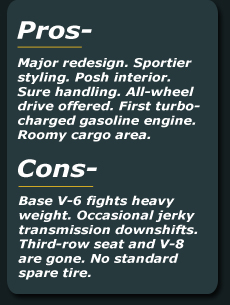2010 Cadillac SRX
Prices: $33,330-$47,540
Cadillac’s SRX sport-utility vehicle has become a smaller,
redesigned luxury crossover vehicle for 2010 and drops its
predecessor’s third-row seat and V-8, It also has front-drive
instead of rear-drive, although an all-wheel drive system is offered.
The advanced all-wheel drive system has an electronic limited-slip
differential and distributes torque from the front to the rear axle and
also side-to-side, across the rear axle. It provides above-average
traction in slippery conditions and enhances other driving dynamics,
such as cornering.
The $33,330 to $47,540 SRX comes in Luxury, Performance and Premium
designations. It’s more affordable than its capable but aged,
conservatively styled predecessor, which wasn’t a hit. The
new model’s tightly wrapped, sweeping body has taillights
that resemble the fins that once helped make Cadillac one of the most
easily identifiable cars.
The new model is well equipped with the comfort, convenience and safety
items one might expect from Cadillac. The power tailgate even has a
programmable height setting to prevent it from hitting the top of, say,
an opened garage door.
Options include heated/ventilated seats,
“Ultra-View” sunroof, rear-seat DVD entertainment
system with screens in the back of the front seats, advanced navigation
system, rear-view camera and 10-speaker Bose 5.1 Digital Surround
sound.
A lavish interior is one of the SRX’s high points. But a firm
rear center seat area in the lavish interior makes the cockpit only
comfortable for four adults. However, leg room is a little tight for a
passenger behind a tall driver with his seat comfortably moved back.
The SRX shifts from the Cadillac CTS-based Sigma platform to the
smaller Theta platform shared with the excellent, but now-defunct
Saturn Vue. Length is down 4.7 inches to 190.3 inches, height is
appreciably lower and wheelbase (distance between axles) is down from
116 inches to 110.5 inches.
With smaller dimensions, elimination of a third seat and spare tire
(one is optional), why come up with such a heavy vehicle?. It weighs
from 4,224 to 4,307 pounds—heavier than many rivals. The most
formidable competitors include the Acura MDX, BMW X3 and last, but not
least, hot Lexus RX. (The previous SRX weighed about 4,438 pounds.)
The weight of the new SRX made the standard 3-liter 265-horsepower V-6
in my test vehicle work fairly heard to deliver decent acceleration,
although this new Caddy is an easy high-speed highway cruiser.
Also offered is Cadillac’s first turbocharged gasoline
engine--a 2.8-liter V-6 that produces 300-horsepower and is available
to cover the loss of V-8 power. However, I’m not sure that
this engine’s additional 35 horsepower and extra torque will
make much of a performance difference, considering the weight of the
SRX.
What’s really needed for the new SRX is the 4.6-liter,
320-horsepower V-8 of the previous model, which also came with a
3.6-liter, 255-horsepower V-6. That V-6 was no fireball, but
had more torque than the 2010 SRX V-6. Another option would be the
3.6-liter, 304-horsepower V-6 that powers Cadillac’s new CTS
Sport Wagon.
But EPA-estimated fuel economy is part of the Washington-auto industry
game now, and the new non-turbo SRX V-6 beats fuel economy of the old
V-6. The new V-6 delivers 18 mpg in the city and 25 on highways with
front-drive and 17 and 23 with all-wheel drive.
Opt for the turbocharged V-6—found in Saabs--and the figures
are 15 city and 21 highway with all-wheel drive, which is the only
drive setup available with this engine.
The turbo engine calls for premium-grade fuel, while standard-grade can
be used for the base V-6.
Both engines work with a six-speed automatic transmission, which
upshifts smoothly, if a bit lazily, and occasionally downshifts
abruptly. The automatic has a manual-shift feature that works well and
helps give the SRX a little more acceleration zest.
Overall, the SRX is most at home on long interstate drives, eating up
miles with its cruise control activated while occupants enjoy the
cabin’s luxury and quietness. Isn’t that what
Cadillacs once were about?
One thing definitely has changed. Old Cadillacs handled sloppily--as
did most American luxury cars. But the SRX has quick, speed-sensitive
steering with strong on-center feel and sharp handling. It’s
rather fun to drive, and an electronic stability control system is
standard to help keep the SRX on the road during trying conditions.
My $44,995 “Performance” SRX model was especially
agile, with all-wheel drive and wider (55-series) tires on 20-inch
wheels, vs. narrower (65-series) tires on the SRX’s standard
18-inch wheels. More rubber on the road always helps.
The firm is firm but comfortably absorbent with the all-independent
suspension, and the the brake pedal has firm but linear action.
Front seats provide good support, backlit gauges are easily read and
side mirrors are huge. Climate and sound system controls are small. The
glovebox is large and there are storage pockets in all doors, although
the rear pockets don’t hold much. A rear center armrest
contains dual cupholders. Up front, the dual cupholders are nicely
positioned on the console, but window controls on the
driver’s door are set a little too far forward.
The opening for the large cargo area is wide, but rather high. Rear
seatbacks flip forward and sit flat to increase cargo space.
There’s a fairly roomy storage well under the cargo floor for
those who don’t order the optional spare tire, which I
recommend for this vehicle over the electric tire inflator.
The new SRX is more suited to the current--and future---market than its
predecessor. I just wish it had more punch to handle its weight more
briskly, although I suspect many Cadillac buyers would feel it has
sufficient power.














